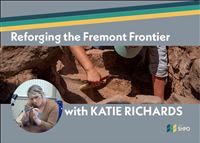Reforging the Fremont Frontier

May 31, 2023 |

***Free live webinar!***
Think you know Fremont archaeology? What Dr. Richards has learned studying Fremont ceramics may surprise you!
For decades, archaeologists have debated how best to interpret the Fremont region. Because of its unique position, the material remains have often presented as an intriguing and confusing syncretic blend of Southwestern and other. Early Fremont archaeologists emphasized the similarities between the Fremont and other groups of the northern Southwest, earning the region the moniker of the Northern Periphery. In subsequent decades, however, archaeologists emphasized that the region was much more than a diluted version of a Puebloan Southwest core by focusing more on local development and downplaying connections to the Southwest. I argue that Fremont is best understood when we explore the complex interplay of local development and Southwestern influence within the context of the social changes that occurred during the Pueblo II and Pueblo III periods in the northern Southwest. Resituating Fremont as the northern periphery presents an engaging history of identity creation and maintenance not evident otherwise.
Peoples living in the Fremont region, located along the far northern extreme of the North American Southwest, demonstrated both a distinct connection to and isolation from their Puebloan neighbors. Around A.D. 1000 many Southwestern traits—aggregated villages, painted pottery, and surface architecture—appeared suddenly in the Fremont region accompanied by an influx in population. Fremont painted bowls provide intriguing clues to understanding Fremont exchange networks, social identity, and the complex relationship between Fremont and Pueblo peoples.
|
Website:
www.eventbrite.com/e/reforging-the-fremont-frontier-tickets-533998011427 |
| |
| Location Information |
|
Virtual Event |
| |
| Contact Information |
|
Elizabeth Hora |
| Email:
ehora@utah.gov |
|